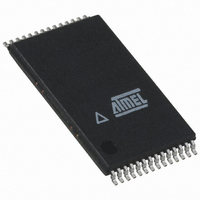AT45DB642D-TU Atmel, AT45DB642D-TU Datasheet - Page 6

AT45DB642D-TU
Manufacturer Part Number
AT45DB642D-TU
Description
IC FLASH 64MBIT 66MHZ 28TSOP
Manufacturer
Atmel
Datasheet
1.AT45DB642D-CU.pdf
(58 pages)
Specifications of AT45DB642D-TU
Format - Memory
FLASH
Memory Type
DataFLASH
Memory Size
64M (8192 pages x 1056 bytes)
Speed
66MHz
Interface
Parallel/Serial
Voltage - Supply
2.7 V ~ 3.6 V
Operating Temperature
-40°C ~ 85°C
Package / Case
28-TSOP
Density
64Mb
Access Time (max)
6ns
Interface Type
Parallel/Serial-SPI
Boot Type
Not Required
Address Bus
1/8Bit
Operating Supply Voltage (typ)
3.3V
Operating Temp Range
-40C to 85C
Package Type
TSOP-I
Program/erase Volt (typ)
2.7 to 3.6V
Sync/async
Synchronous
Operating Temperature Classification
Industrial
Operating Supply Voltage (min)
2.7V
Operating Supply Voltage (max)
3.6V
Word Size
8b
Number Of Words
8M
Supply Current
15mA
Mounting
Surface Mount
Pin Count
28
Data Bus Width
8 bit
Architecture
Sectored
Supply Voltage (max)
3.6 V
Supply Voltage (min)
2.7 V
Maximum Operating Current
15 mA
Mounting Style
SMD/SMT
Organization
256 KB x 32
Memory Configuration
8192 Pages X 1056 Bytes
Clock Frequency
66MHz
Supply Voltage Range
2.7V To 3.6V
Memory Case Style
TSOP
Rohs Compliant
Yes
Lead Free Status / RoHS Status
Lead free / RoHS Compliant
Available stocks
Company
Part Number
Manufacturer
Quantity
Price
Company:
Part Number:
AT45DB642D-TU
Manufacturer:
MICRON
Quantity:
101
Company:
Part Number:
AT45DB642D-TU
Manufacturer:
ATMEL
Quantity:
9 396
Company:
Part Number:
AT45DB642D-TU
Manufacturer:
AT
Quantity:
5
Part Number:
AT45DB642D-TU
Manufacturer:
ATMEL/爱特梅尔
Quantity:
20 000
5. Device Operation
6. Read Commands
6.1
6
Continuous Array Read (Legacy Command: E8H): Up to 66 MHz
AT45DB642D
The device operation is controlled by instructions from the host processor. The list of instructions
and their associated opcodes are contained in
page
opcode and the desired buffer or main memory address location. While the CS pin is low, tog-
gling the SCK/CLK pin controls the loading of the opcode and the desired buffer or main memory
address location through either the SI (serial input) pin or the 8-bit input pins (I/O7 - I/O0). All
instructions, addresses, and data are transferred with the most significant bit (MSB) first.
Buffer addressing for standard DataFlash page size (1056 bytes) is referenced in the datasheet
using the terminology BFA10 - BFA0 to denote the 11 address bits required to designate a byte
address within a buffer. Main memory addressing is referenced using the terminology PA12 -
PA0 and BA10 - BA0, where PA12 - PA0 denotes the 13 address bits required to designate a
page address and BA10 - BA0 denotes the 11 address bits required to designate a byte address
within the page.
For “Power of 2” binary page size (1024 bytes) the Buffer addressing is referenced in the
datasheet using the conventional terminology BFA9 - BFA0 to denote the 10 address bits
required to designate a byte address within a buffer. Main memory addressing is referenced
using the terminology A22 - A0.
By specifying the appropriate opcode, data can be read from the main memory or from either
one of the two SRAM data buffers. The DataFlash supports RapidS and Rapid8 protocols for
Mode 0 and Mode 3. Please refer to the “Detailed Bit-level Read Timing” diagrams in this
datasheet for details on the clock cycle sequences for each mode.
By supplying an initial starting address for the main memory array, the Continuous Array Read
command can be utilized to sequentially read a continuous stream of data from the device by
simply providing a clock signal; no additional addressing information or control signals need to
be provided. The DataFlash incorporates an internal address counter that will automatically
increment on every clock cycle, allowing one continuous read operation without the need of
additional address sequences. To perform a continuous read from the standard DataFlash page
size (1056 bytes), an opcode of E8H must be clocked into the device followed by three address
bytes (which comprise the 24-bit page and byte address sequence) and a series of don’t care
bytes (4 bytes if using the serial interface or 19 bytes if using the 8-bit interface). The first 13 bits
(PA12 - PA0) of the 24-bit address sequence specify which page of the main memory array to
read, and the last 11 bits (BA10 - BA0) of the 24-bit address sequence specify the starting byte
address within the page. To perform a continuous read from the binary page size (1024 bytes),
the opcode (E8H) must be clocked into the device followed by three address bytes and a series
of don’t care bytes (4 bytes if using the serial interface, or 19 bytes if using the 8-bit interface).
The first 13 bits (A22 - A10) of the 24-bits sequence specify which page of the main memory
array to read, and the last 10 bits (A9 - A0) of the 24-bits address sequence specify the starting
byte address within the page. The don’t care bytes that follow the address bytes are needed to
initialize the read operation. Following the don’t care bytes, additional clock pulses on the
SCK/CLK pin will result in data being output on either the SO (serial output) pin or the eight out-
put pins (I/O7- I/O0).
31. A valid instruction starts with the falling edge of CS followed by the appropriate 8-bit
Table 15-1 on page 28
through
3542K–DFLASH–04/09
Table 15-6 on













